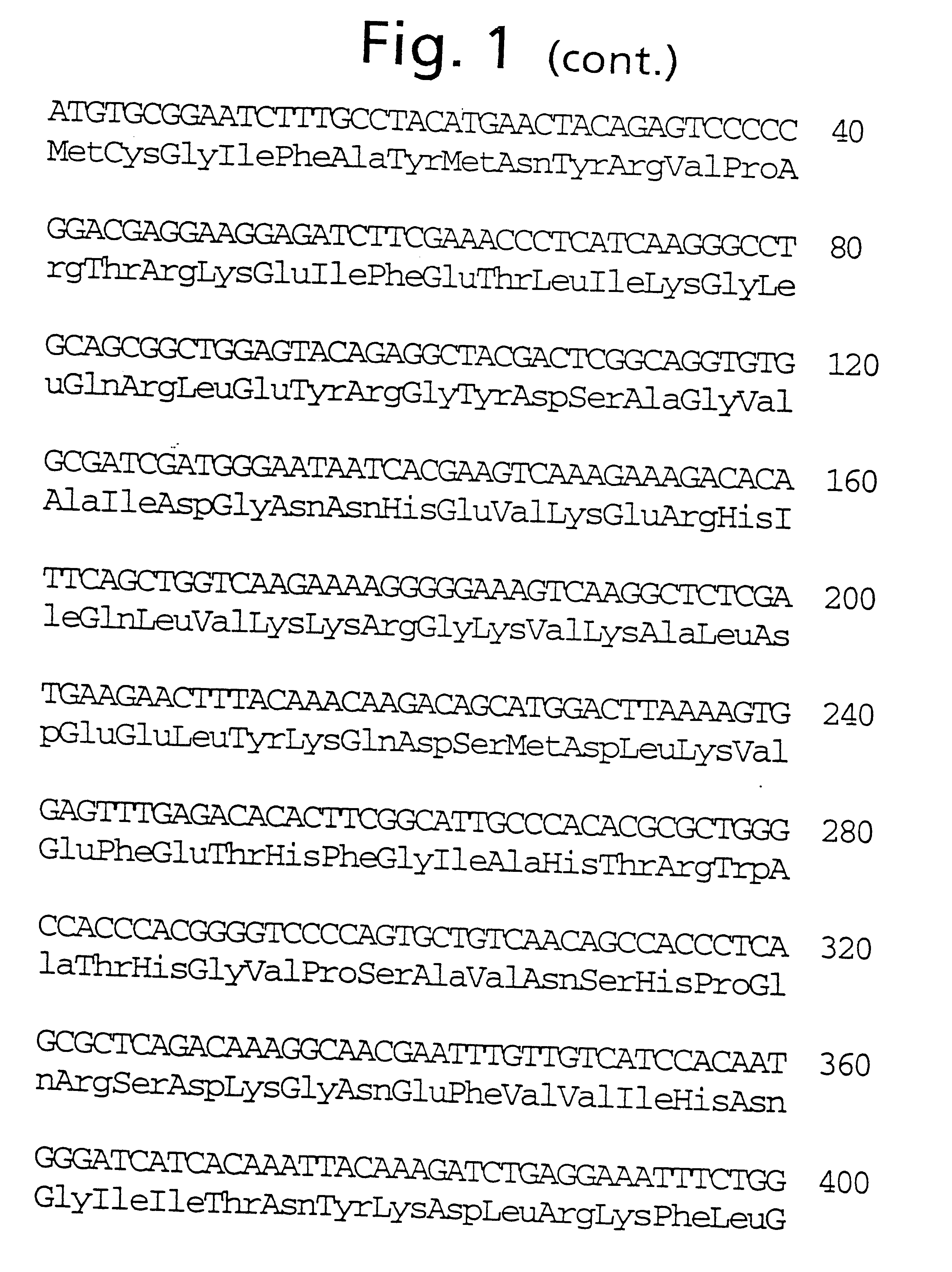Glutamine:fructose-6-phosphate amidotransferase, its production and use
a technology of amidotransferase and fructose-6-phosphate, which is applied in the direction of transferases, peptide/protein ingredients, enzymology, etc., can solve the problem of insufficient insulin activity
- Summary
- Abstract
- Description
- Claims
- Application Information
AI Technical Summary
Benefits of technology
Problems solved by technology
Method used
Image
Examples
reference example 1
Cloning of a Gene Coding for a Novel Protein: TGC028-2
Cloning of the cDNA encoding a novel protein:
TGC028-2 was performed using the GENETRAPPER.TM. cDNA Positive Selection System (GIBCO BRL).
The Escherichia coli DH12S cells harboring SUPERSCRIPT.TM. human brain cDNA library (GIBCO BRL) was cultured in terrific broth (12 g / L Bacto-tryptone (Difco), 24 g / L Bacto yeast extract (Difco), 2.3 g / L monopotassium phosphate, 12.5 g / L dipotassium phosphate, 4% glycerol) containing 100 .mu.g / ml ampicillin at 30.degree. C. for 16 hours, and the plasmid cDNA library was extracted and purified using a QIAGEN Plasmid Kit (QIAGEN). The purified plasmid cDNA library was digested with Gene II and ExoIII (each from GIBCO BRL) to give the single-stranded cDNA library.
On the other hand, a synthetic oligonucleotide (SEQ ID NO:13) was used as a probe for screening a positive cDNA clone. The probe was biotinylated at the 3'-end by using TdT and biotin-14-dCTP (GIBCO BRL). The single-stranded cDNA library wa...
example 1
Cloning of a Gene Coding for the Novel Protein: TGC028-3
Cloning of the cDNA encoding the novel protein:
TGC028-3 was performed using the GENETRAPPER.TM. cDNA Positive Selection System (GIBCO BRL).
The Escherichia coli DH12S cells harboring a human brain-derived cDNA library (GIBCO BRL) was cultured in terrific broth (12 g / L Bacto-tryptone (Difco), 24 g / L Bacto yeast extract (Difco), 2.3 g / L monopotassium phosphate, 12.5 g / L dipotassium phosphate) at 30.degree. C. for 16 hours, and the plasmid cDNA library was extracted and purified using QIAGEN Plasmid Kit (QIAGEN). The purified plasmid cDNA library was digested with Gene II and ExoIII (each from GIBCO BRL) to provide a single-stranded cDNA library.
On the other hand, a synthetic oligonucleotide (SEQ ID NO:16) was used as a probe for screening the positive cDNA clone. The probe was biotinylated at the 3'-end by using TdT and biotin-14-dCTP (GIBCO BRL). After the single-stranded cDNA library was treated at 95.degree. C. for 1 minute, ch...
example 2
Construction of a Gene Coding for the Novel Protein: TGC028-4
A 1788-base long nucleotide sequence was obtained from a plasmid DNA containing the open reading frame for TGC028-3 by digesting with the restriction enzymes EcoRV and BamHI. Separately, a strain of Escherichia coli harboring a plasmid containing a GFAT-like DNA fragment was cultured, the plasmid DNA was extracted therefrom, and the fragment excised with the restriction enzymes BamHI and SalI was recovered. Each fragment was inserted into a plasmid vector (pET 32a (+), Novagen) treated with the restriction enzymes EcoRV and SalI to thereby construct a plasmid named pTB1944 (FIG. 4). pTB1944 contained, in the vicinity of the termination codon, a sequence for 65 amino acid residues not found in TGC028-3. It contained an open reading frame consisting of the 2046-base long nucleotide sequence represented by SEQ ID NO:6 which encodes a gene product composed of 682 amino acid residues represented by in SEQ ID NO:3 (FIG. 2).
The p...
PUM
 Login to View More
Login to View More Abstract
Description
Claims
Application Information
 Login to View More
Login to View More - R&D
- Intellectual Property
- Life Sciences
- Materials
- Tech Scout
- Unparalleled Data Quality
- Higher Quality Content
- 60% Fewer Hallucinations
Browse by: Latest US Patents, China's latest patents, Technical Efficacy Thesaurus, Application Domain, Technology Topic, Popular Technical Reports.
© 2025 PatSnap. All rights reserved.Legal|Privacy policy|Modern Slavery Act Transparency Statement|Sitemap|About US| Contact US: help@patsnap.com



